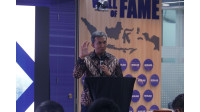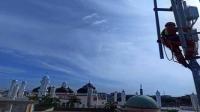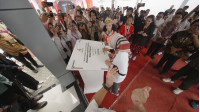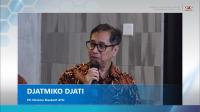Indonesia is the largest market in Southeast Asia for satellite market
07:15:34 | 09 Feb 2017
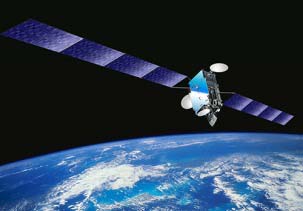
ilustrasi
JAKARTA (IndoTelko) - Indonesia is the largest market in Southeast Asia for commercial satellite communications and the market here continues to grow rapidly.
Mobile trunking and backhaul continue to be the biggest segment of the Indonesian satellite communications market. But the second biggest segment, and fastest growing, is demand for satellite communications from the corporate sector.
“Big corporate users of satellite communications include the Indonesian banks, which want to expand their ATM networks. The fastest way to expand your network of ATMs or other equipment connected to the internet, is through satellite communications,” says President of the Singapore Space & Technology Association (SSTA) Jonathan Hung who was in Jakarta to promote the association’s upcoming Global Space Technology Convention (GSTC), which will be held at Singapore’s Marriott Hotel from the 23-24 February.
This year is SSTA’s 10th anniversary, so it anticipates that this year’s convention will be the biggest ever. Those attending include: space agencies, satellite manufacturers and satellite operators from around Asia Pacific as well as from North America, Middle East and Europe.
“The growth and success of GSTC is due in part to the fact that Asia’s satellite industry has been growing and that countries in the region Asia have become important markets in the global space industry,” says Hung. “Indonesia is clearly a very important market in the global satellite industry,” says Hung, who points out that Indonesia has more communications satellite operators than any other country in Southeast Asia. The Indonesian satellite operators are: Bank Rakyat Indonesia (BRI), Indosat Ooredoo, Media Citra Indostar (MCI), Pasifik Satelit Nusantara and Telkom Indonesia. "Even though Indonesia already has a good number of satellites, demand is increasing so much that Indonesian satellite operators are working to launch more satellites to serve the market. Telkom has announced it is launching its Telkom 3S satellite next week on February 15. Pasifik Satelit Nusantara, meanwhile, is launching its PSN-6 in the coming months and Telkom plans to launch a Telkom 4 satellite next year,” says Hung. Indonesia’s Ministry of Communications and Information Technology has also said publicly it wants to make use of satellite technology as part of Palapa Ring, a government-led project to bring internet connectivity to the masses including to people in remote areas. “Demand for satellite communications here will continue to grow, based on the fact Indonesia is a vast archipelago of 17,000 islands with a population of 225 million people, an increasing number of which are mobile phone, satellite TV and consumer broadband users,” says Hung. “There will always be the debate over satellite versus cable, but in an archipelago as big as Indonesia, satellite is often the only feasible way to provide services to people,” he adds. While mobile trunking and backhaul is the largest segment of the satellite communications industry in Indonesia followed by corporate sector, the other segments in order of size are video services and consumer broadband, says Hung. The huge demand in Indonesia for mobile phone services, video services, consumer broadband as well as the growth in Indonesia’s banks and corporate sector means we anticipate that Indonesia’s satellite communications industry will continue to experience more than 10% growth per annum in the years to come, he says. “One of the key trends in the corporate sector, is that more and more machines are becoming connected to the internet. When I say machines, I don’t just mean computers. I also mean industrial equipment like power stations, marine vessels, aircraft and so on. This is driving demand for satellite communications. For example, the only way to ensure an aircraft or sea vessels have internet connectivity is through satellite communications,” he adds.
Besides using satellites for communications, another important use of satellites is for earth-observation (EO). The Indonesian National Institute of Aeronautics & Space (LAPAN) has a lead role in Indonesia when it comes to developing EO satellites. It has successfully developed several EO satellites over the years, the most recent being LAPAN A3 which launched into space last June. “EO satellites are very useful for Indonesia because the satellites can be used to monitor and protect Indonesia’s borders and exclusive economic zone (EEZ) out at sea. These satellites can also be used to monitor land use and help protect the environment and natural resources,” says Hung.
“We can see that several government ministries in Indonesia are taking a keen interest in EO satellites and are looking to use EO satellite technology to help in the work that they do. For example, Indonesia’s ministry of marine affairs and fisheries is looking at how it can use nanosatellites to monitor and manage sea vessels entering Indonesia’s sea waters. This will also be very useful for helping to stop illegal fishing and piracy.” He also says Indonesian authorities are using EO satellites to monitor volcanoes.
“The resolution of EO satellites continues to improve. The resolution has become so good, EO satellites can now detect ash clouds as they emerge from the volcanic vent. This satellite imagery can then be used to warn people about impending volcanic eruptions, so people have time to evacuate.” (es)
Baca juga :
•
•
•
“The growth and success of GSTC is due in part to the fact that Asia’s satellite industry has been growing and that countries in the region Asia have become important markets in the global space industry,” says Hung. “Indonesia is clearly a very important market in the global satellite industry,” says Hung, who points out that Indonesia has more communications satellite operators than any other country in Southeast Asia. The Indonesian satellite operators are: Bank Rakyat Indonesia (BRI), Indosat Ooredoo, Media Citra Indostar (MCI), Pasifik Satelit Nusantara and Telkom Indonesia. "Even though Indonesia already has a good number of satellites, demand is increasing so much that Indonesian satellite operators are working to launch more satellites to serve the market. Telkom has announced it is launching its Telkom 3S satellite next week on February 15. Pasifik Satelit Nusantara, meanwhile, is launching its PSN-6 in the coming months and Telkom plans to launch a Telkom 4 satellite next year,” says Hung. Indonesia’s Ministry of Communications and Information Technology has also said publicly it wants to make use of satellite technology as part of Palapa Ring, a government-led project to bring internet connectivity to the masses including to people in remote areas. “Demand for satellite communications here will continue to grow, based on the fact Indonesia is a vast archipelago of 17,000 islands with a population of 225 million people, an increasing number of which are mobile phone, satellite TV and consumer broadband users,” says Hung. “There will always be the debate over satellite versus cable, but in an archipelago as big as Indonesia, satellite is often the only feasible way to provide services to people,” he adds. While mobile trunking and backhaul is the largest segment of the satellite communications industry in Indonesia followed by corporate sector, the other segments in order of size are video services and consumer broadband, says Hung. The huge demand in Indonesia for mobile phone services, video services, consumer broadband as well as the growth in Indonesia’s banks and corporate sector means we anticipate that Indonesia’s satellite communications industry will continue to experience more than 10% growth per annum in the years to come, he says. “One of the key trends in the corporate sector, is that more and more machines are becoming connected to the internet. When I say machines, I don’t just mean computers. I also mean industrial equipment like power stations, marine vessels, aircraft and so on. This is driving demand for satellite communications. For example, the only way to ensure an aircraft or sea vessels have internet connectivity is through satellite communications,” he adds.
Artikel Terkait
-
 English Ver. - 04:06:00 | 25 Aug 2025The collaboration is designed to simplify complex payment processes for global travel businesses
English Ver. - 04:06:00 | 25 Aug 2025The collaboration is designed to simplify complex payment processes for global travel businesses -
 English Ver. - 04:07:00 | 11 Aug 2025Wireless Logic has completed the acquisition of Zipit Wireless
English Ver. - 04:07:00 | 11 Aug 2025Wireless Logic has completed the acquisition of Zipit Wireless -
 English Ver. - 05:00:00 | 27 Jul 2025JLL’s involvement included identifying and securing a site that met DAMAC’s technical and strategic requirements
English Ver. - 05:00:00 | 27 Jul 2025JLL’s involvement included identifying and securing a site that met DAMAC’s technical and strategic requirements
Rekomendasi
Berita Pilihan
More Stories
PR Newswire








.jpeg)



